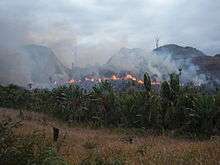Land use, land-use change and forestry
Land use, land-use change and forestry (LULUCF) is defined by the United Nations Climate Change Secretariat as "A greenhouse gas inventory sector that covers emissions and removals of greenhouse gases resulting from direct human-induced land use, land-use change and forestry activities."[1]
LULUCF has impacts on the global carbon cycle and as such, these activities can add or remove carbon dioxide (or, more generally, carbon) from the atmosphere, influencing climate. LULUCF has been the subject of two major reports by the Intergovernmental Panel on Climate Change (IPCC). Additionally, land use is of critical importance for biodiversity.
Climatic impacts of land-use, land-use change and forestry

Land-use change can be a factor in CO2 (carbon dioxide) atmospheric concentration, and is thus a contributor to climate change. IPCC estimates that land-use change (e.g. conversion of forest into agricultural land) contributes a net 1.6 ± 0.8 Gt carbon per year to the atmosphere. For comparison, the major source of CO2, namely emissions from fossil fuel combustion and cement production amount to 6.3 ± 0.6 Gt carbon per year.[2]
This decision sets out the rules that govern how Kyoto Parties with emission reduction commitments (so-called Annex 1 Parties) account for changes in carbon stocks in land use, land-use change and forestry. It is mandatory for Annex 1 Parties to account for changes in carbons stocks resulting from deforestation, reforestation and afforestation (B Article 3.3) [3] and voluntary to account for emissions from forest management, cropland management, grazing land management and revegetation (B. Article 3.4).
The rules governing the treatment of land use, land-use change and forestry for the second commitment period are part of the Bali Action Plan under the Ad Hoc Working Group on Further Commitments for Annex 1 Parties under the Kyoto Protocol (AWG-KP).[4]
The most recent options for rule changes under consideration are summarized in a "Non-Paper" the co-chairs of the contact group on LULUCF (as of June 12).[5]
Land use and biodiversity

The extent, and type of land use directly affects wildlife habitat and thereby impacts local and global biodiversity. Human alteration of landscapes from natural vegetation (e.g. wilderness) to any other use typically results in habitat loss, degradation, and fragmentation, all of which can have devastating effects on biodiversity. Land conversion is the single greatest cause of extinction of terrestrial species.[6] An example of land conversion being a chief cause of the critically endangered status of a carnivore is the reduction in habitat for the African wild dog, Lycaon pictus.[7]
Of particular concern is deforestation, where logging or burning are followed by the conversion of the land to agriculture or other land uses. Even if some forests are left standing, the resulting fragmented landscape typically fails to support many species that previously existed there.
See also
References
- ↑ Land use, land-use change, and forestry (LULUCF), Glossary of climate change acronyms, UNFCCC website. Retrieved 2009-01-11.
- ↑ "Vital Climate Graphics | UNEP/GRID-Arendal - Publications - Vital Climate Graphics". Grida.no. Retrieved 2010-04-29.
- ↑ "Microsoft Word - kpcmp8a3.doc" (PDF). Retrieved 2010-04-29.
- ↑ AWG-KP begins final year of work, UNFCCC website. Retrieved 2009-10-11.
- ↑ A text on other issues outlined in document FCCC/KP/AWG/2008/8, UNFCCC website. Retrieved 2009-10-11.
- ↑ Bierregaard, Richard; Claude Gascon, Thomas E. Lovejoy, and Rita Mesquita (eds.) (2001). Lessons from Amazonia: The Ecology and Conservation of a Fragmented Forest. ISBN 0-300-08483-8. Cite uses deprecated parameter
|coauthors=(help) - ↑ C. Michael Hogan. 2009. Painted Hunting Dog: Lycaon pictus, GlobalTwitcher.com, ed. N. Stromberg
External links
- Good Practice Guidance for Land Use, Land-Use Change and Forestry
- IPCC Special Report on Land Use, Land-Use Change, and Forestry
| ||||||||||||||||||||||||||||||
| ||||||||||||||||||||
